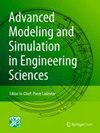物理结构对横流微通道热交换器性能指标的作用及回归分析
IF 3.2
Q3 MECHANICS
Advanced Modeling and Simulation in Engineering Sciences
Pub Date : 2024-08-27
DOI:10.1186/s40323-024-00271-5
引用次数: 0
摘要
微通道热交换器已成为电子、制冷和热管理系统等现代技术的首选。微通道热交换器之所以受欢迎,是因为其设计紧凑、效率出众,优于传统热交换器(HE)。尽管人们一直在努力,但仍未找到能加强热管理、最大限度减少压降和提高整体性能的最佳微通道。本研究旨在加深我们对横流微通道热交换器(CFMCHE)内热量传输和流体动力学的理解。通过数值建模,研究了通道几何形状、通道间距、通道数量和入口速度等物理方面如何影响压降、效率、努塞尔特数和整体效率等关键性能指标。为了改进设计,我们分析了六种独特形状的横流微通道热交换器:圆形、六边形、梯形、正方形、三角形和矩形。我们采用 Galerkin 开发的加权残差有限元法,对三维共轭偏微分耦合方程进行数值计算。我们介绍了每种形状的数值结果,重点是表面温度、压降和温度等值线。此外,计算还包括功效、与泵功率相关的传热率以及整体性能指标。研究结果表明,虽然圆形 CFMCHE 的传热率最高,但与方形 CFMCHE 相比,其性能较差。性能不佳的主要原因是圆形通道的压降增大,其有效率比方形通道降低了 1.03%。因此,方形水道的性能指数增长率为 53.57%,成为六种形状中最有效的设计。此外,对于方形 CFMCHE,我们还绘制了残余误差图,并提出了一个多变量线性回归方程,其相关系数为 0.8026。本文章由计算机程序翻译,如有差异,请以英文原文为准。
Role of physical structure on performance index of crossflow microchannel heat exchanger with regression analysis
Microchannel heat exchangers have become the preferred choice in contemporary technologies like electronics, refrigeration, and thermal management systems. Their popularity stems from their compact design and exceptional efficiency, which outperform traditional heat exchangers (HE). Despite ongoing efforts, the optimal microchannels for enhancing heat management, minimizing pressure drop, and boosting overall performance have yet to be identified. This study seeks to deepen our understanding of heat transmission and fluid dynamics within a cross-flow microchannel heat exchanger (CFMCHE). Utilizing numerical modeling, it examines how various physical aspects—such as channel geometry, spacing between channels, the number of channels, and the velocity at the inlet—affect key performance indicators like pressure drop, effectiveness, Nusselt number, and overall efficiency. To enhance the design, we analyze six unique shapes of crossflow microchannel heat exchangers: circular, hexagonal, trapezoidal, square, triangular, and rectangular. We employ the Galerkin-developed weighted residual finite element method to numerically address the governing three-dimensional conjugate partial differential coupled equations. The numerical results for each shape are presented, focusing on the surface temperature, pressure drop, and temperature contours. Additionally, calculations include the efficacy, the heat transfer rate in relation to pumping power, and the overall performance index. The findings reveal that while circular shapes achieve the highest heat transfer rates, they underperform compared to square-shaped CFMCHEs. This underperformance is largely due to the increased pressure drop in circular channels, which also exhibit a 1.03% greater reduction in effectiveness rate than their square-shaped counterparts. Consequently, square-shaped channels, boasting a performance index growth rate of 53.57%, emerge as the most effective design among the six shapes evaluated. Additionally, for the square-shaped CFMCHE, we include residual error plots and present a multiple-variable linear regression equation that boasts a correlation coefficient of 0.8026.
求助全文
通过发布文献求助,成功后即可免费获取论文全文。
去求助
来源期刊

Advanced Modeling and Simulation in Engineering Sciences
Engineering-Engineering (miscellaneous)
CiteScore
6.80
自引率
0.00%
发文量
22
审稿时长
30 weeks
期刊介绍:
The research topics addressed by Advanced Modeling and Simulation in Engineering Sciences (AMSES) cover the vast domain of the advanced modeling and simulation of materials, processes and structures governed by the laws of mechanics. The emphasis is on advanced and innovative modeling approaches and numerical strategies. The main objective is to describe the actual physics of large mechanical systems with complicated geometries as accurately as possible using complex, highly nonlinear and coupled multiphysics and multiscale models, and then to carry out simulations with these complex models as rapidly as possible. In other words, this research revolves around efficient numerical modeling along with model verification and validation. Therefore, the corresponding papers deal with advanced modeling and simulation, efficient optimization, inverse analysis, data-driven computation and simulation-based control. These challenging issues require multidisciplinary efforts – particularly in modeling, numerical analysis and computer science – which are treated in this journal.
 求助内容:
求助内容: 应助结果提醒方式:
应助结果提醒方式:


